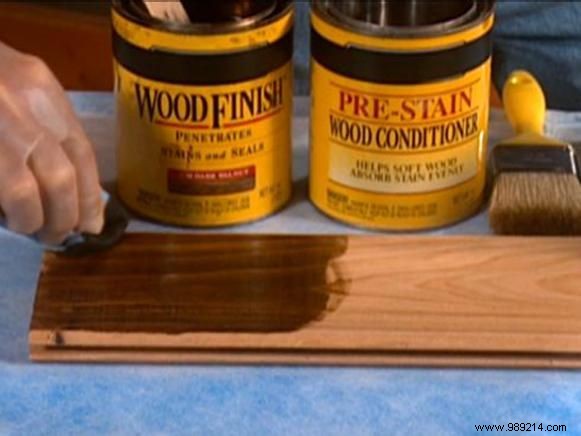
A DIY can save money by staining unfinished furniture. But stains are scary because they are permanent, and DIYers have to be careful. There are also a plethora of products to use, including oil-based and water-based stains and wood conditioners, which can be confusing. Here are some ways to avoid common staining pitfalls.
When working with stains, protect eyes and skin with safety glasses and disposable rubber gloves. Remember, anything that can permanently stain wood will also stain your fingers. Also wear old clothes to work as some stains might spill.
- Always test the stain on a piece of wood before starting on the furniture.
- So that the stain does not leave stains on the wood, always apply a thin layer of wood conditioner first, using a cheap brush. Let the conditioner dry about 15 minutes before applying the stain, but do not sand it; no need.
- Oil-based stains, which are the most common, consist of dyes and pigments mixed with mineral spirits. Be sure to shake the can thoroughly before staining to get the dyes and pigments out of the bottom, in order to get the full color of the stain. When working with oil-based stains there will be fumes, so make sure you always work in a well-ventilated area.
- Apply the stain with a brush or a cloth, depending on preference. Using a tint brush, work both with and against the grain. Don't worry about being clean; all that matters is getting a nice, even coat on the wood. At this point, wipe the stain immediately for a lighter shade, or for a deeper shade, leave it on for five or even 10 minutes before wiping.
- Be sure to wipe off all excess stain that goes with the grain of the wood. That will ensure that the stain soaks into the wood, rather than set on top of it, and really shows the grain of the wood to your advantage.
- To avoid fumes, go with a water-based stain. One of the advantages of water-based stains is that they come in a wide variety of colors, even more colors than oil. Apply water-based stain in the same way as oil.
- If the stain needs to be darker, go back and apply more stain.
- The stain only provides color, not a finish. Always apply a finish on top of stained wood. Or, if time is short, look for a product that combines the stain and finish in one coat. The product will need to be brushed more carefully, finishing with the grain of the wood. Use a higher quality brush with this type of stain/finish.
- It is possible to mix the stain to make a custom color, as long as both are made by the same manufacturer and both are water or oil based. Do not mix oil and water. Measure the amounts of each stain used and write it down, so it can be doubled if necessary.
- A water-based finish can be put over an oil-based stain, but only after waiting 24 hours for all mineral spirits to evaporate from the oil-based stain. If it rains or is cold, give it an extra 24 hours.
- Keep old cans from staining. Stains can be expensive, and the nice thing about them is that they don't tend to settle on the can, like the finish. If there is a fur coat on top when the can is opened, throw it away. But otherwise, it's still good to use.